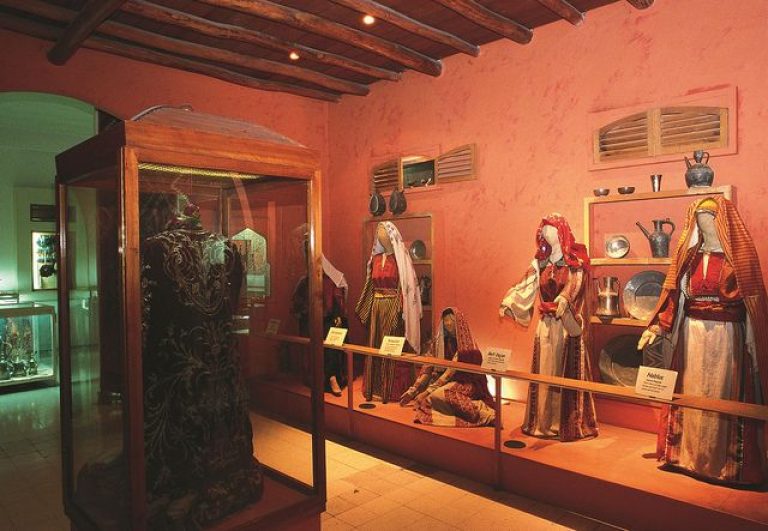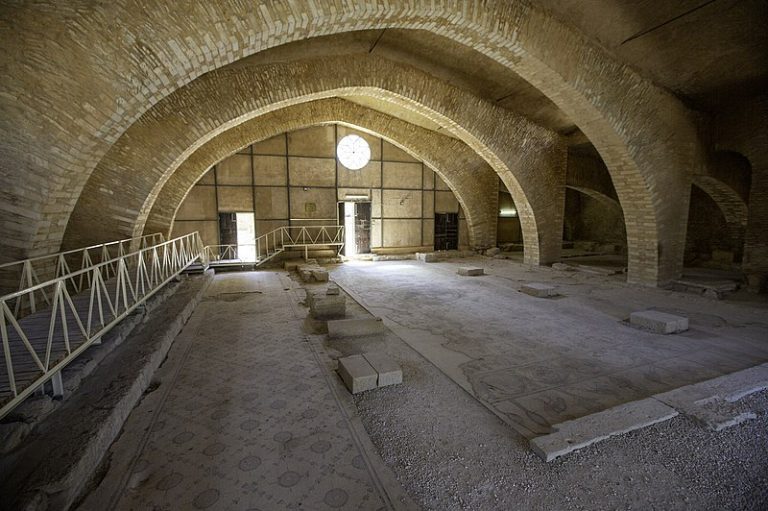Madaba is one of the most memorable places in the Holy Land. Dubbed “the City of Mosaics,” Madaba offers many sites to explore. The chief attraction in the contemporary Greek Orthodox church of St. George – is a wonderfully vivid, 6th century Byzantine mosaic map showing Jerusalem and other holy sites.
With two million pieces of coloured stone, and a full 25×5 metres in its original state – most of which can still be seen today – the map depicts hills and valleys, villages and towns, as far away as the Nile Delta. This masterpiece is unrivalled in Jordan, but there are literally dozens of other mosaics from the 5-th through the 7-th centuries scattered throughout Madaba’s churches and homes. In line with Jordan’s commitment to restoring and preserving its mosaic masterpieces, Madaba’s extensive archaeological park and museum complex encompasses the remains of several Byzantine churches, including the outstanding mosaics of the Church of the Virgin and the Hyppolytus Hall, part of a 6th century mansion.
Close to the archaeological park is the Mosaic School of Madaba, which operates under the patronage of the Ministry of Tourism. The only project of its kind in the Middle East, the school trains artisans in the art of making, repairing and restoring mosaics.
Madaba, the “City of Mosaics.” Embark on a journey through time as you explore its captivating historical sites, from the world-renowned Madaba Map to the stunning ruins of ancient churches and lively marketplaces, each telling a unique story of faith and artistry.

St. George’s Church in Madaba, Jordan, is a historical and religious treasure renowned for housing the Madaba Map, the oldest preserved and detailed ancient map of the Holy Land. This Byzantine church, constructed in the late 19th century on the ruins of a much earlier Byzantine chapel, draws visitors and scholars for its beautiful mosaics, particularly the map that depicts Jerusalem and other holy sites as they appeared in the 6th century.
The Madaba Map is an extraordinary piece of art and cartography, featuring over two million pieces of colored stone, and provides significant insights into the geography and topography of the Eastern Mediterranean region during the Byzantine period. The church itself, while modest in size, showcases remarkable architecture with intricate designs typical of Byzantine ecclesiastical structures.
Beyond the map, the church contains other mosaics found throughout the area, including depictions of towns, animals, and daily life scenes that illustrate the cultural and historical context of the region during the early Christian period. These artworks not only highlight the artistic prowess of the period but also serve as an archaeological cache that offers a window into the past.
Visitors to St. George’s Church can also explore the surroundings of Madaba, a city known for its rich collection of Byzantine and Umayyad mosaics. The city itself is an important site for religious tourism in Jordan, providing a deeper understanding of the region’s extensive historical and religious significance.
In addition to its mosaics, St. George’s Church functions as an active place of worship and a community center for the local Christian community in Madaba. The church’s role extends beyond being just a tourist attraction; it is a living part of the community that contributes to the religious and cultural life of the city.
For those interested in religious history, ancient art, and archaeology, St. George’s Church offers a profound and enriching experience. It stands as a testament to the historical continuity and the rich tapestry of religious and cultural traditions in Jordan. Visitors leave with a greater appreciation of the Christian heritage in the Middle East and the intricate history woven into the fabric of Madaba.
The Madaba Archaeological Museum, located in the historic city of Madaba, Jordan, serves as a key repository of regional artifacts and mosaics, showcasing the area’s rich history from the Byzantine and Umayyad periods. Established to preserve and display these artifacts, the museum houses a remarkable collection, including detailed mosaics, pottery, glass, and religious artifacts that narrate the story of Madaba and its historical significance in the Middle East. This museum not only enriches visitors’ understanding of Jordan’s archaeological wealth but also highlights Madaba’s pivotal role in the religious and cultural history of the region. With its artifacts systematically arranged and informatively presented, the museum offers a comprehensive view of the area’s past civilizations, making it an essential stop for history enthusiasts exploring Jordan.


The Madaba Folkloric Museum offers a deep dive into the traditional Jordanian lifestyle and culture. Situated in the city of Madaba, this museum provides a vivid display of local customs through its extensive collection of folkloric artifacts, including traditional costumes, textiles, domestic tools, and pottery. These exhibits not only illustrate daily life in historical Madaba but also celebrate the rich artistic heritage of the region, particularly in embroidery and ceramic craftsmanship. The museum’s setting in a traditional Jordanian house further enhances the authentic experience, giving visitors a genuine feel for the architectural styles and living conditions of past times. This cultural hub is essential for those looking to understand the social fabric and artisan skills of Jordan.
Madaba Archaeological Park showcases a treasure trove of mosaic art and archaeological findings from various epochs, particularly from the Byzantine and Umayyad periods. Located in the historic city of Madaba, Jordan, this park spans several locations, including the remnants of ancient churches and public buildings. Visitors can explore beautifully preserved mosaic floors that depict ancient myths, religious scenes, and everyday activities, offering insight into the historical and cultural life of the region. The park is an essential visit for those interested in the artistry and archaeology of the Middle East, providing a vivid connection to Jordan’s past civilizations.


The Church of the Apostles in Madaba, Jordan, is renowned for its stunning 6th-century mosaic floor. Dedicated to the memory of the twelve apostles, this masterpiece captures intricate depictions of flora, fauna, and ancient towns. The church itself, built in 578 AD, is a significant archaeological and religious site, reflecting the rich Christian heritage of the region. Its central mosaic is particularly famous for its detailed representation of the Sea of Galilee and the Jordan River, drawing visitors and scholars alike to admire its artistic and historical significance.
The people of Madaba, Jordan, are known for their warm hospitality and rich cultural heritage. This town is predominantly inhabited by Christians and Muslims who live together harmoniously, reflecting a diverse and vibrant community. Madaba’s residents are proud of their city’s historical and religious significance, often engaging in traditional crafts such as mosaic making, which has been passed down through generations. Their friendly nature makes visitors feel welcome, enhancing the cultural experience of exploring Madaba’s historical sites and culinary delights.
In Madaba, accommodations range from charming guesthouses to upscale hotels, offering options for every budget and preference. Many establishments feature traditional Jordanian decor and modern amenities, ensuring a comfortable stay. Dining in Madaba allows visitors to experience the rich flavors of Middle Eastern cuisine. Local restaurants serve a variety of traditional dishes, such as mansaf and falafel, in settings that range from casual street food stalls to finer dining venues, often complemented by the warm hospitality Jordan is known for.

